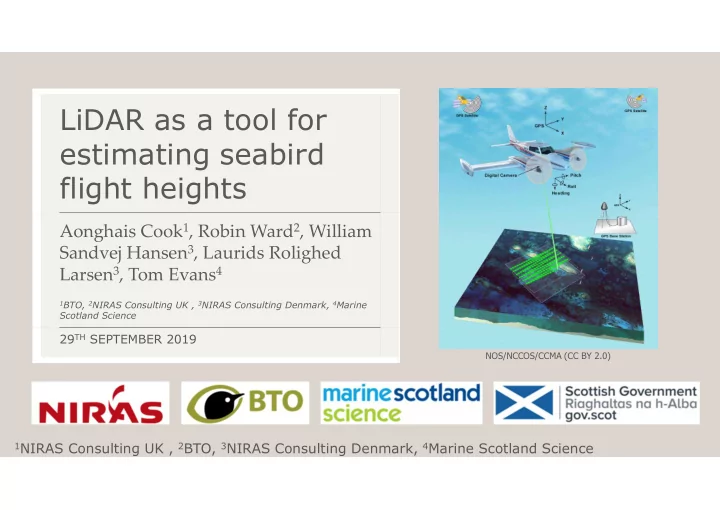

LiDAR as a tool for estimating seabird flight heights Aonghais Cook 1 , Robin Ward 2 , William Sandvej Hansen 3 , Laurids Rolighed Larsen 3 , Tom Evans 4 1 BTO, 2 NIRAS Consulting UK , 3 NIRAS Consulting Denmark, 4 Marine Scotland Science 29 TH SEPTEMBER 2019 NOS/NCCOS/CCMA (CC BY 2.0) 1 NIRAS Consulting UK , 2 BTO, 3 NIRAS Consulting Denmark, 4 Marine Scotland Science
Seabird flight heights Johnston et al. 2014 Ross-Smith et al. 2014 Johnston & Cook 2016 Digital aerial GPS BOAT survey Understanding height at which seabirds fly key part of assessing collision risk • Can be assessed using boat/digital aerial surveys, or GPS tags • Significant uncertainty surrounding estimates from these platforms • Patterns vary in both space & time • 2
LiDAR Light Detection and Ranging (light based • Radar) Very precise measurements • Photo by Andrew Ngeow, courtesy of Oregon State University (CC BY-SA 2.0) Widely used tool for ecology • Habitat mapping • Airborne insects • Aerial obstructions to aircraft • Can we use it to measure the heights of • seabirds in flight? Validation • Field based survey • 3 NOS/NCCOS/CCMA (CC BY 2.0)
Validation Key question – can LiDAR accurately • measure heights of moving objects? 3 Drones flown at known heights • Drones detected on every flight • LiDAR flight height estimates • compared to those obtained using drones onboard GPS & photogrammetry techniques All estimates within 1 m, minimum • difference 17 cm 4
Surveys Aim for minimum 100 birds per • species 300 m above sea-level & speed of 240 • km/h LiDAR point density 11 points / m 2 • Camera GSD 3.5 cm • Surveys 20 th & 22 nd September 2017 • N-S transects covered once each, E-W • transects 3 times each 5
Image processing Height of every point in the LiDAR cloud measured in relation to European • Terrestrial Reference System 89 Sea surface clutter meant it was necessary to filter out points <1-2 m above sea • level, potential for +ve bias to mean flight height estimates Points above 2 m identified as birds • Height estimates independent of • height of aircraft 6
Image processing Points matched to photograph & passed to ornithologist for ID Speed of aircraft meant each set of points referred to a single bird 7
Species detected Over 2,200 birds identified • Most common gannets (377) & • kittiwakes (806) Also, large gulls, auks, terns & • great skua Issue with vibration in camera • images (not sufficiently secured?) meant identifying gulls difficult 8
Flight heights Potential for birds flying at higher altitudes not to be detected when further • from transect line Limit analyses to birds within 125 m of transect line • 9
Comparing flight height distributions Kittiwake Gannet LiDAR – this • study Digital Aerial • – Johnston et al. 2014, J. Applied Ecology 51:31-41 Boat – • Johnston and Cook 2016, BTO Research Report No. 676 10
Spatial distribution of flight heights Collision risk height Below CRH 11
Spatial distribution of flight heights Kittiwake Gannet 12
Kittiwake Gannet Unidentified gulls Combining distribution Bird density and flight height Flight height Flight height with bird density overlaid
Conclusion • LiDAR is an accurate & precise method for measuring seabird flight heights • Sea clutter means data must be filtered – can detect birds > 2 m or lower depending on conditions – may be possible to refine this • More important for auks etc. than gulls • Still precautionary (% birds at CRH will be overestimated) • Can use data to produce continuous flight height distributions • Can also look at spatial patterns in bird flight heights 14
Thanks! Funding: • Thanks to Helica S. R. L. for supplying LiDAR equipment & Fugro for advice • Thanks to Airtask Group for carrying out surveys • BTO & NIRAS colleagues for support & advice on this project 15
Estimating Seabird Flight Height Using LiDAR Cook, A.S.C.P., Ward, R.M., Hansen, W.S. and Larsen, L. (2018) Scottish Marine and Freshwater Science Vol 9 no 14 https://data.marine.gov.scot/dataset/ estimating-seabird-flight-height- using-lidar 16
Recommend
More recommend